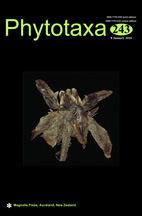Abstract
A new species of marine macroalgae, Botryocladia franciscana sp. nov. (Rhodophyta, Rhodymeniaceae) is described for the south-west Atlantic Ocean. B. franciscana was collected from protected rocky crevices at Coqueiro Beach, Piaui, Brazil. Molecular characterization was based on two plastidial genes, the V domain of the 23S rRNA gene (UPA, universal plastid amplicon), and the large subunit of ribulose-1, 5-bisphosphate carboxylase oxygenase gene (rbcL), and the mitochondrial cytochrome oxidase I gene (cox1). Phylogenetic trees from rbcL sequences clearly set B. franciscana apart from morphologically similar B. bermudana and B. caraibica. Morphological description was performed using anatomical and morphological features, including vesicle medulla and wall thickness, shape and size of the mucous-filled vesicles, pattern of vesicles’ outer cortication, number of secretory cells and type of cell bearing the secretory cells. The observed morphological characters do not correspond to any previously described Botryocladia species and DNA sequence diverge values indicate it is distinct from B. franciscana and B. bermudana; therefore, we present B. franciscana as a new species from the Brazilian coast, with illustrations and morpho-anatomical characteristics.

